When it comes to land surveying, choosing the right drone can make all the difference in efficiency and accuracy. With advanced features and high-quality cameras, the best models on the market simplify your work while enhancing data collection. From GPS-assisted navigation to impressive flight times, these drones are designed with surveyors in mind. Want to find out which specific models stand out and what factors you should consider before making a choice?
N11 Pro 4K UHD Camera Drone for Adults
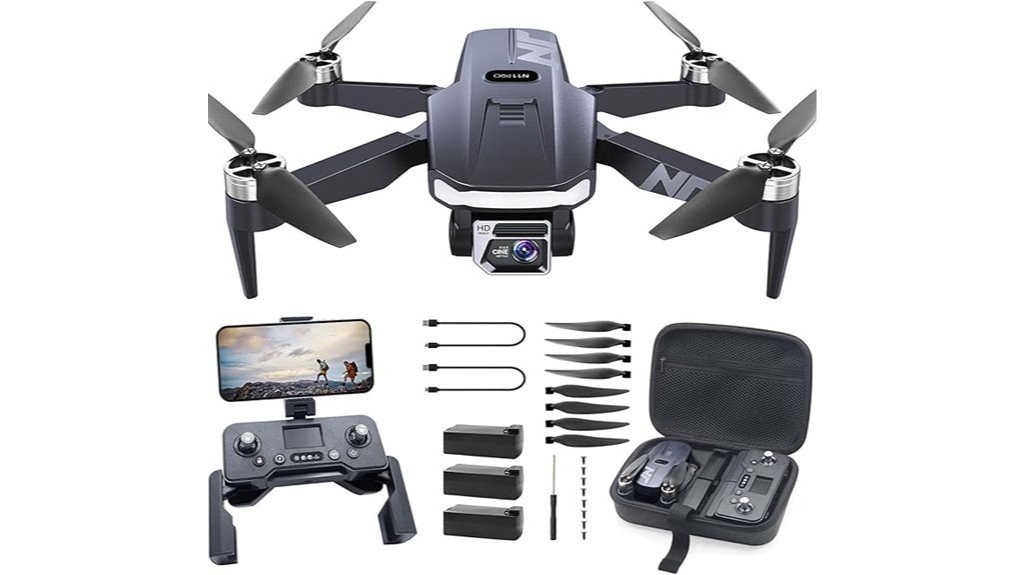
The N11 Pro 4K UHD Camera Drone is an excellent choice for adults, especially those new to flying. Weighing under 0.55 lbs, it’s FAA-free, making it hassle-free to operate. With up to 90 minutes of flight time and a control range of 3,328 feet, you’ll enjoy extended aerial exploration. Its 4K camera captures stunning photos and videos, while GPS and optical flow guarantee precise navigation. The auto return function and Follow Me technology enhance safety and convenience. Plus, with an average rating of 4.9 stars, users rave about its stability and ease of use, perfect for both indoor and outdoor adventures.
Best For: Adults and new flyers looking for an easy-to-use drone with impressive camera capabilities and safety features.
Pros:
- Excellent 4K camera for high-quality photos and videos.
- Long flight time of up to 90 minutes with a control range of 3,328 feet.
- User-friendly design with GPS assistance and auto return functionality.
Cons:
- Limited to a weight under 0.55 lbs, which may restrict some advanced features.
- Battery life may decrease over time with frequent use.
- Some users might find the learning curve steep for advanced maneuvers.
Ruko F11GIM2 Drone with 4K Camera
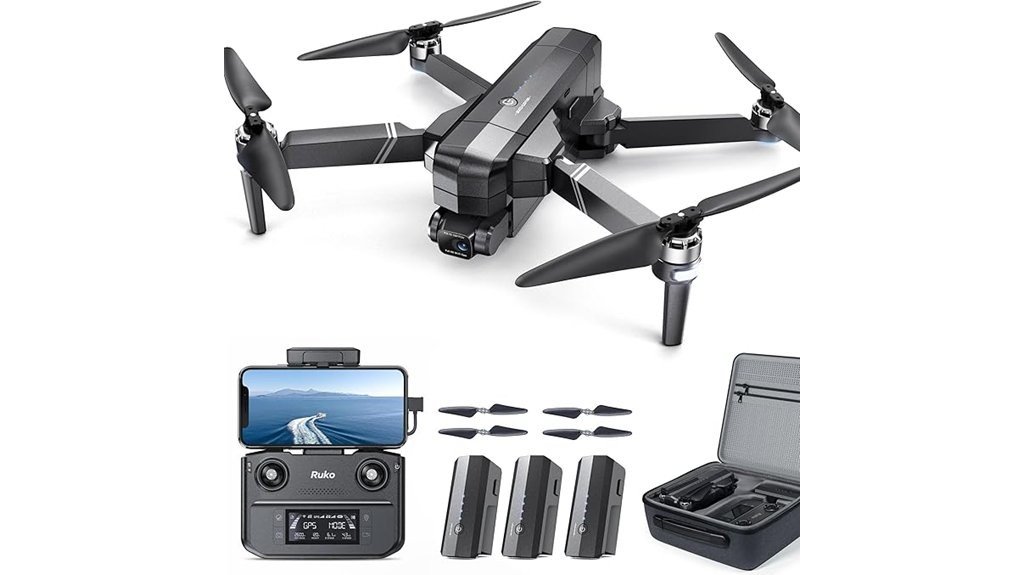
For those venturing into land surveying, the Ruko F11GIM2 Drone with its impressive 4K camera stands out as an exceptional choice. With a flight time of 96 minutes and a maximum range of 16,404 feet, it guarantees you can cover extensive areas efficiently. The 2-axis gimbal and electronic image stabilization deliver stunning video quality, while features like GPS smart return and auto follow enhance usability. It’s beginner-friendly, too, thanks to intuitive controls and instructional resources. Although some users report occasional control lag, overall, you’ll appreciate its sturdy build, long battery life, and excellent customer support for your surveying needs.
Best For: The Ruko F11GIM2 Drone is best for beginners and experienced users looking for an affordable and feature-rich drone for land surveying and aerial photography.
Pros:
- Sturdy build and excellent HD camera quality for capturing detailed images.
- Long flight time of 96 minutes with three included batteries, allowing extended use.
- User-friendly controls and comprehensive instructional resources for easy piloting.
Cons:
- Some users experience occasional control lag during operation.
- Reports of motor sticking and gyroscope malfunctions may affect performance.
- Missing or loose screws have been noted by a few customers, raising concerns about quality control.
Ruko F11PRO 2 Drone with 6K Camera
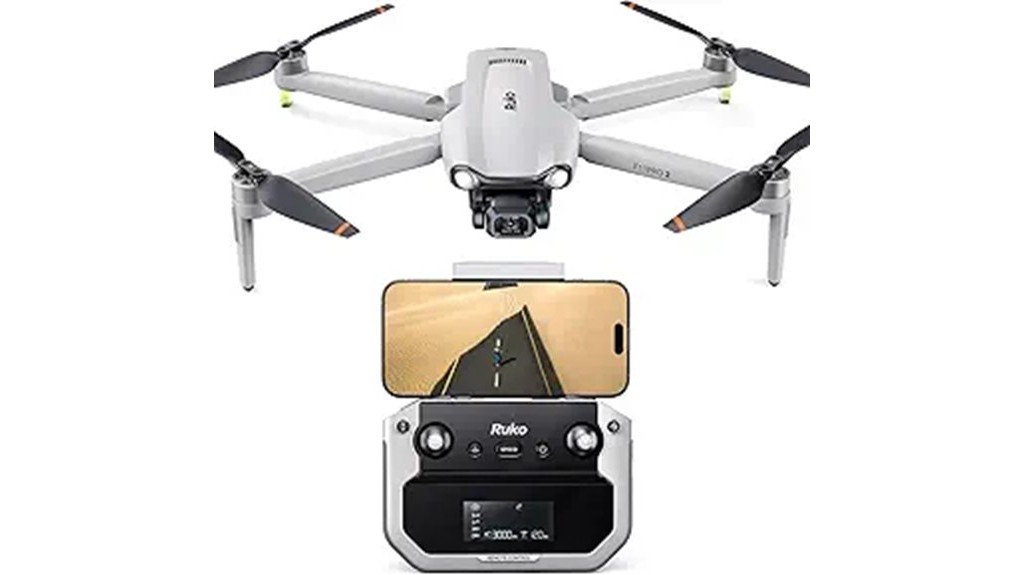
With its impressive 6K camera, the Ruko F11PRO 2 Drone stands out as an exceptional choice for land surveyors seeking high-quality aerial imagery. The advanced image sensor captures finer details and vibrant colors, ensuring exceptional clarity in your surveys. Thanks to the 3-axis brushless gimbal, you’ll enjoy superior stability and smooth footage, even in windy conditions. Plus, with two batteries providing a total of 70 minutes of flight time, you won’t miss a moment. Its intelligent flight features like waypoint planning make operation easy, allowing you to focus on capturing professional-level visuals with minimal effort.
Best For: The Ruko F11PRO 2 Drone is best for land surveyors and photography enthusiasts seeking high-quality aerial imagery with advanced features.
Pros:
- 6K camera offers exceptional detail and clarity in aerial imagery.
- 3-axis brushless gimbal ensures stability and smooth footage even in windy conditions.
- 70 minutes of total flight time with two batteries allows for extensive aerial coverage.
Cons:
- Requires the Ruko charger for optimal performance, limiting charging options.
- May have a learning curve for beginners unfamiliar with drone operation.
- Limited range of intelligent flight features compared to some higher-end models.
TD31LCD RC Drone with LCD Screen
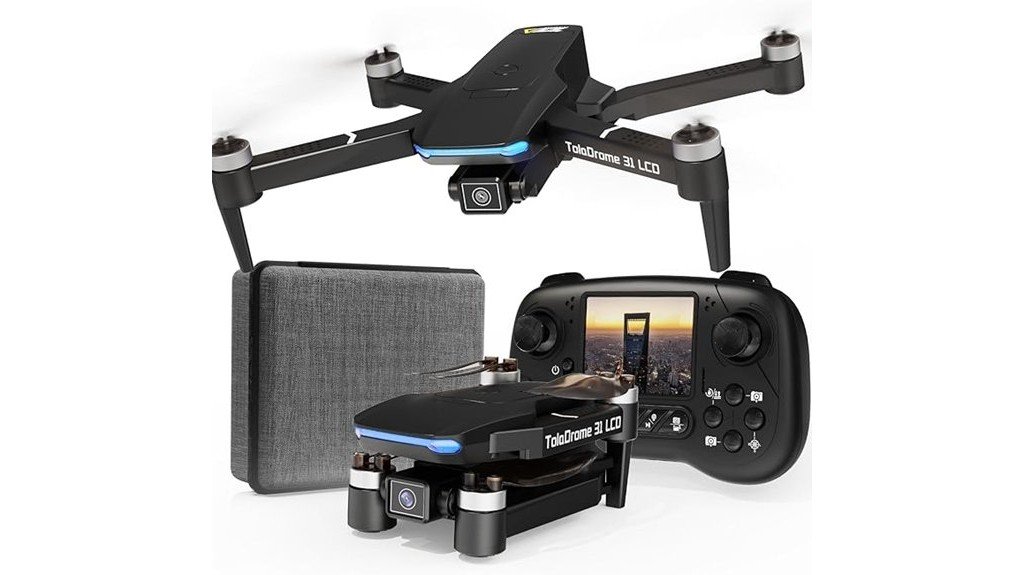
Designed for both beginners and experienced users, the TD31LCD RC Drone with LCD Screen stands out for its user-friendly interface and convenient digital image transmission. You’ll appreciate the built-in LCD display, allowing real-time viewing without needing an app. With four powerful brushless motors, it guarantees a quiet and stable flight. Plus, its foldable design makes it easy to transport. You can store photos and videos on a 32GB SD card, while features like headless mode and one-key take-off simplify operation. Rated 4.1 stars, it’s a solid choice for reliable aerial photography and surveying tasks.
Best For: The TD31LCD RC Drone with LCD Screen is best for beginners and hobbyists looking for an easy-to-use drone for aerial photography.
Pros:
- User-friendly interface with a built-in LCD display for real-time viewing without an app.
- Stable flight performance thanks to four powerful brushless motors.
- Foldable design for easy transport and storage, perfect for outdoor adventures.
Cons:
- Limited battery life with approximately 15 minutes of flight time.
- Mixed reviews on camera quality and video performance.
- SD card not included, requiring an additional purchase for photo and video storage.
Bwine F7GB2 Pro Drone with Camera
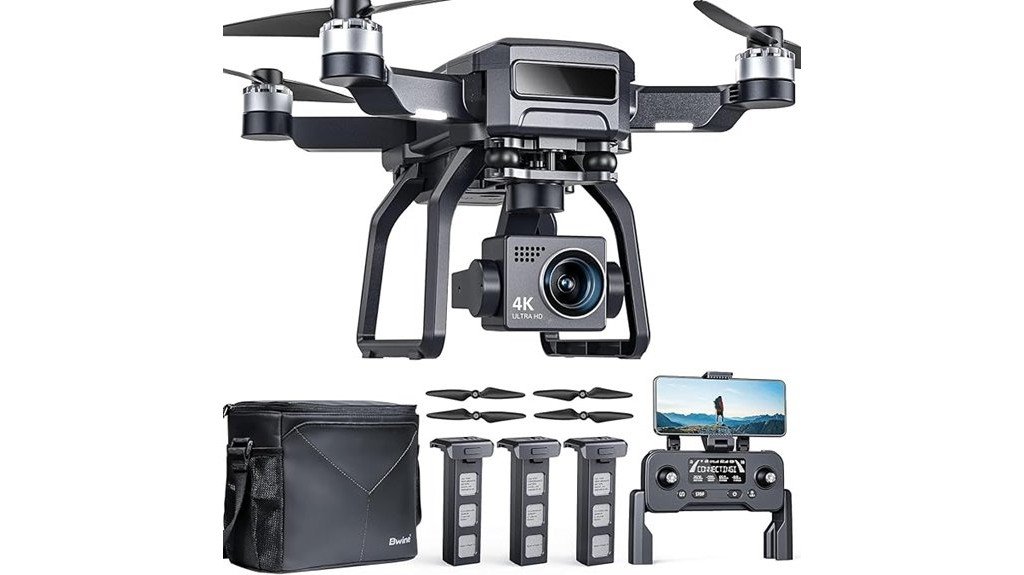
The Bwine F7GB2 Pro Drone stands out as an exceptional choice for land surveying professionals, thanks to its impressive 4K UHD camera equipped with a 3-axis gimbal. You’ll appreciate the 120° field of view and 5x digital zoom, capturing high-resolution images and videos effortlessly. With a flight range of 10,000 feet and a remarkable 75-minute flight time, this drone guarantees extensive coverage. Its smart GPS functionality offers reliable auto-return and waypoint navigation, making it user-friendly. Plus, the drone’s robust wind resistance and stable performance assure accurate data collection, essential for precise surveying tasks. You’ll love the ease of use and support!
Best For: The Bwine F7GB2 Pro Drone is best for land surveying professionals seeking high-quality imaging and reliable performance for data collection.
Pros:
- High-resolution 4K UHD camera with 3-axis gimbal for stable footage and clear images.
- Long flight time of up to 75 minutes with three included batteries, allowing for extensive coverage.
- User-friendly GPS functionality, including auto return and waypoint navigation for ease of operation.
Cons:
- Weighs 550 grams, which may be considered heavy for some users.
- Requires FAA registration and compliance, potentially complicating initial use for beginners.
- Fast charging takes approximately 1.5 hours, which may limit quick turnaround for flights.
Factors to Consider When Choosing a Drone for Land Surveying
When you’re choosing a drone for land surveying, there are several key factors to keep in mind. You’ll want to take into account the camera resolution and quality, as well as the flight time duration to guarantee you can complete your tasks efficiently. Don’t forget about GPS features, payload capacity, and how easy the drone is to operate; these elements can greatly impact your surveying experience.
Camera Resolution and Quality
Camera resolution and quality play a vital role in land surveying, impacting the accuracy and reliability of your results. A high camera resolution, ideally 4K (3840×2160 or higher), guarantees you capture the detailed images necessary for precise surveys. Additionally, a larger sensor size enhances image quality by gathering more light, which is important for varying lighting conditions. Incorporating gimbals, whether 2-axis or 3-axis, stabilizes your footage, reducing motion blur and improving image clarity. Zoom capabilities allow you to inspect specific areas without getting too close, maintaining a safe distance from sensitive locations. Finally, shooting in various formats like MP4 provides flexibility for video capture and post-processing, essential for producing thorough survey reports.
Flight Time Duration
Flight time duration is one of the most critical factors to evaluate when choosing a drone for land surveying. Longer flight times reduce the need for frequent battery changes, allowing you to cover more ground in a single session. Drones with flight times exceeding 30 minutes are generally preferred, as they efficiently complete larger surveys without interruption. Keep in mind that total flight time can be influenced by payload weight, wind conditions, and battery capacity, so consider these factors when selecting your drone. A drone capable of flying for 60 minutes or more greatly increases productivity by minimizing downtime. Additionally, assess the number of batteries included, as multiple batteries extend operational time and enable back-to-back flights during your surveying activities.
GPS and Navigation Features
While traversing the complexities of land surveying, having a drone equipped with advanced GPS and navigation features can greatly enhance your accuracy and efficiency. GPS-assisted drones provide precise positioning, essential for accurate mapping tasks. Many models offer dual navigation systems, combining GPS with optical flow for enhanced stability during flights, whether indoors or outdoors. Automated functions like smart return guarantee your drone returns safely to its starting point in case of low battery or signal loss, minimizing data loss risks. With waypoint navigation, you can pre-program flight paths for systematic surveying, guaranteeing thorough area coverage. Additionally, drones with long control ranges allow you to cover vast terrains without frequently relocating, making your surveying process smoother and more efficient.
Payload Capacity Considerations
When selecting a drone for land surveying, understanding payload capacity is essential, as it directly affects the quality of your data collection. A drone’s ability to carry equipment like high-resolution cameras or LiDAR sensors determines the accuracy of your results. Drones with higher payload capacities allow you to add extra batteries or stabilization gear, enhancing flight stability and extending operational time. Always consider the total weight of the drone and its payload; exceeding the manufacturer’s limits can compromise performance and safety. The design and materials of a drone also impact its capacity, with lightweight composites enabling higher limits while maintaining efficiency. Many surveying drones offer payload capacities ranging from 1 kg to over 5 kg, so choose one that fits your specific requirements.
Ease of Use
Choosing a drone for land surveying can be intimidating, especially if you’re new to the technology. To ease your learning curve, look for drones with intuitive controls and user-friendly interfaces. Features like one-key return and auto landing enhance safety and simplify the flying experience, making them ideal for beginners. Advanced stabilization technology, such as brushless motors or gimbals, is essential for capturing accurate survey data. Additionally, consider drones that offer real-time transmission capabilities, allowing you to monitor flights and make adjustments on-the-fly. Finally, evaluate the availability of instructional materials like manuals or tutorial videos, as these resources can greatly assist you in mastering drone operation for effective land surveying.
Stability in Windy Conditions
To guarantee accurate land surveying, it’s vital to select a drone that excels in stability during windy conditions. Look for models rated at level 6 or higher for wind resistance, ensuring they can handle breezy environments. A drone equipped with a 3-axis gimbal is essential; it minimizes wind-induced vibrations, keeping your footage smooth and your images precise. Powerful brushless motors enhance propulsion, offering stable flight even in gusty winds. Don’t overlook GPS functionality, as it helps maintain a stable position and reduces drift when conditions get tough. Finally, prioritize flight time—longer battery life means you can conduct thorough surveys without constant interruptions, especially critical in rapidly changing weather. Stability is key to reliable surveying results.

